Wednesday, 2023-02-08

Our first attempt at doing Korean BBQ at home was a great success, and now my wife got even more excited and very enthusiastic about making her own kimchi for the second BBQ at home. In our first attempt, we only had Napa Kimchi, also known as Baechu Kimchi. This time we use slightly different ingredients and more variety of homemade kimchi. The main ingredients of our choice this time were fish, pork, and beef. Grilling these meats on a hot pan will give them a delicious, charred flavor and ensure they are cooked to perfection. We did not marinate or season them before grilling instead, we made dipping sauces for the grilled meats.
What is Korean BBQ?
Korean barbecue (KBBQ) refers to the Korean method of grilling meat, usually beef, pork, or chicken, at the table on a gas or charcoal grill built into the dining table. Diners then wrap the cooked meat with fresh vegetables, such as lettuce or perilla leaves, and dips it into a variety of seasonings and sauces. Korean BBQ is a popular and social style of dining, enjoyed with family and friends.
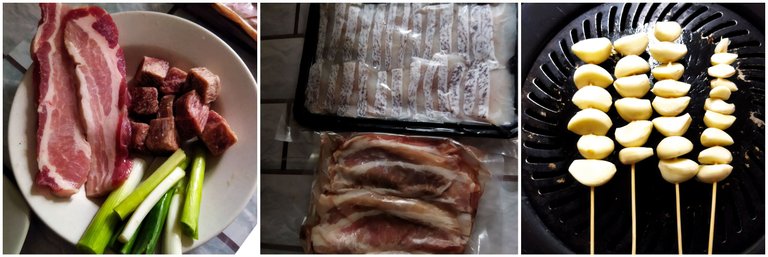
The main ingredients; pork, beef, fish, garlic, and spring onions. They will be grilled.

We grilled them on a pan and here they are.
We used a variety of fresh greens like Romaine lettuce, butterhead, lollorosa, and perilla to wrap the grilled meats. They provide a crisp texture and a neutral flavor that balance out the spices and seasonings in the meats and dipping sauces. To wrap the meats, simply place a piece of grilled meat on a leaf of lettuce or perilla, add a little bit of kimchi, and roll everything up.
Dipping Sauce
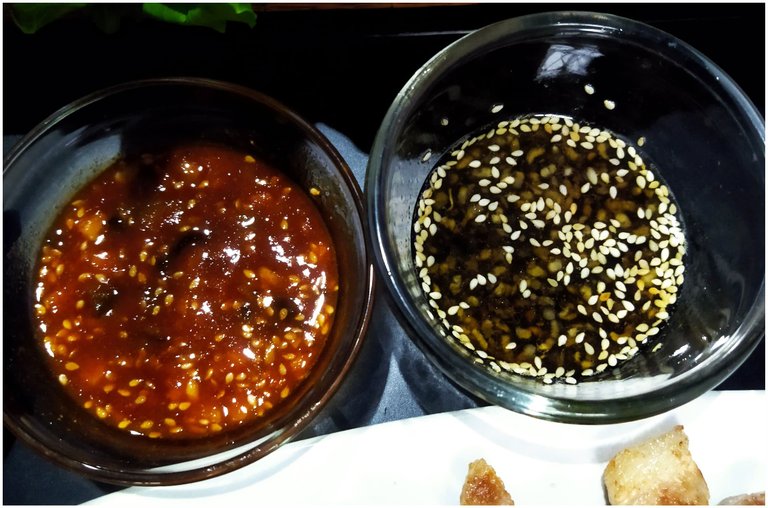
Homemade dipping sauce: Ssamjang (left) and Soy sauce & sesame oil (right).
We also made a homemade dipping sauce from a combination of soy sauce, sesame oil, finely chopped garlic, and roasted sesame seeds. It provided a savory and nutty flavor that complemented the grilled meats and kimchi nicely.
Another homemade dipping sauce is called Ssamjang which is a Korean dipping sauce that is used in a popular Korean dish called "ssam" which involves wrapping meats, vegetables, and rice in lettuce leaves or other greens. Ssamjang is made with a combination of ingredients that includes fermented soybean paste (doenjang), gochujang (red chili pepper paste), sesame oil, garlic, green onions, and other seasonings. The sauce is thick, slightly sweet, and spicy with a savory umami flavor, and it provides a bold and flavorful complement to the grilled meats and fresh greens in the "ssam." Ssamjang is an essential condiment in Korean cuisine and is enjoyed by many as a dipping sauce for grilled meats or as a spread for rice or vegetables.
Kimchi
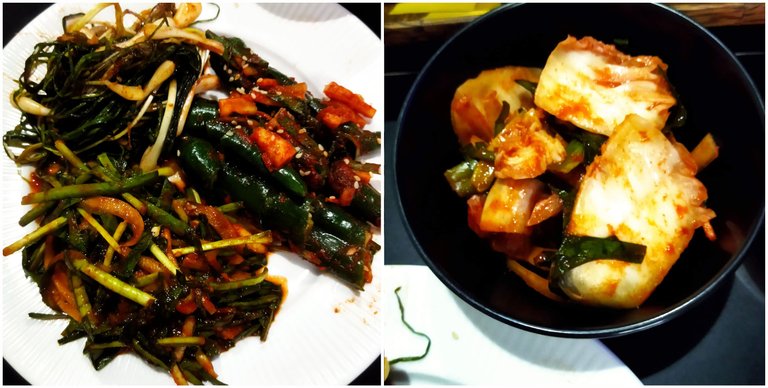
Homemade kimchi: Chives, Scallion & stuffed green chili kimchi (left), and napa kimchi (right).
Napa Kimchi, also known as Baechu Kimchi, is a type of Korean pickled vegetable dish made with Napa cabbage as the main ingredient. Napa cabbage is sliced and mixed with a spicy, tangy seasoning mixture that usually includes chili pepper flakes, garlic, ginger, fish sauce, and other seasonings. The mixture is then left to ferment, resulting in a flavorful and slightly sour condiment that is often served as a side dish with Korean meals. Napa Kimchi is a staple in Korean cuisine and is considered to be one of the most popular types of kimchi.
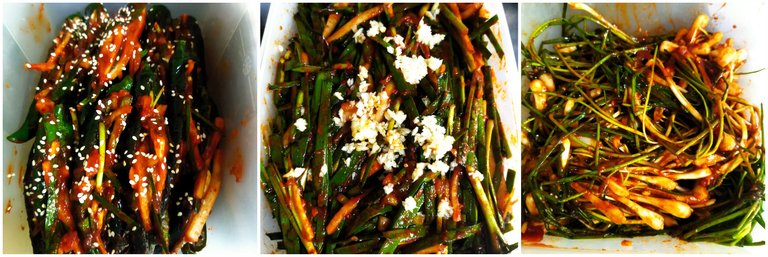
Homemade stuffed green chili (left), chives (center), and scallion kimchi (right).
Kucai Kimchi is a type of Korean pickled vegetable dish made with chives as the main ingredient. Chives are sliced and mixed with a spicy, tangy seasoning mixture that usually includes chili pepper flakes, garlic, ginger, fish sauce, and other seasonings. The mixture is then left to ferment, resulting in a flavorful and slightly sour condiment that is often served as a side dish with Korean meals. Kucai Kimchi is a popular variation of traditional kimchi and can be enjoyed as a standalone dish or as an ingredient in other Korean dishes.
Scallion Kimchi is a type of Korean pickled vegetable dish made with sliced scallions (green onions) mixed with a spicy, tangy seasoning mixture. It is usually made by soaking the scallions in a brine solution and then mixing them with chili pepper flakes, garlic, ginger, fish sauce, and other seasonings.
Stuffed Green Chili Kimchi, on the other hand, is a type of kimchi that is made by stuffing whole green chili peppers with a mixture of spices, seasonings, and vegetables, such as garlic, ginger, and onion. The stuffed chili peppers are then left to ferment, resulting in spicy and flavorful kimchi. Both scallion kimchi and stuffed green chili kimchi are popular variations of traditional kimchi and can be enjoyed as a side dish, condiment, or ingredient in other Korean dishes.
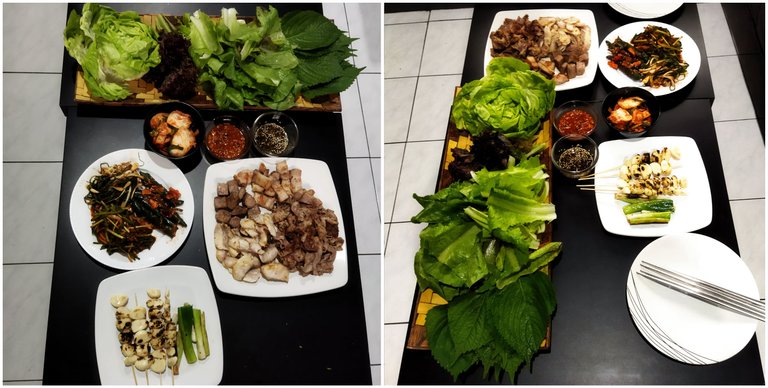
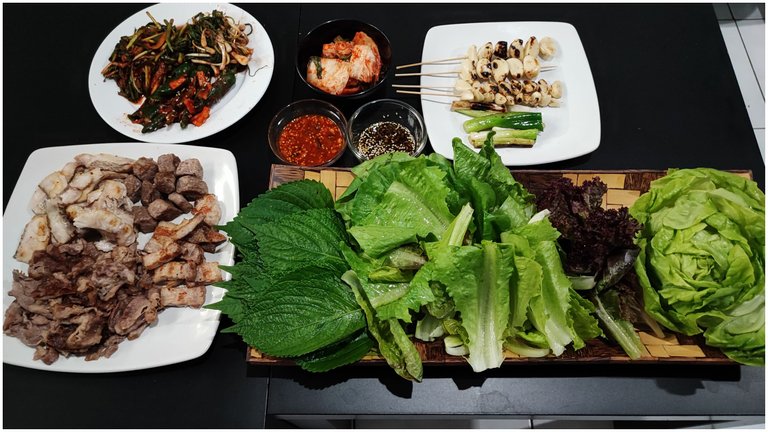
We used Perilla, romaine, lollorosa, and butterhead lettuce for the wrap.
We have been to several Korean BBQ restaurants in town, but I have to admit that our home Korean BBQ tasted just as good if not better. There is something special about cooking and enjoying food in the comfort of home. We can ensure the cleanliness of the fresh vegetables that are washed and the quality of the meat. In our country, tap water is unsafe to drink and most people are still using well water to wash their vegetables with. Water quality is a major concern in many developing countries, particularly when it comes to washing fruits and vegetables. Poor water quality, due to contamination from sewage, industrial waste, and other sources, can lead to foodborne illness and serious health problems.
Thank you for reading and for your support.
All images and/or videos in this post are created by me, otherwise, they will be specified. You can also support me by clicking this link or the image on the right. 🙂
 |
A baby boomer who's trying to embrace and adapt to the new digital world. Worked for over 30 years in the IT industry before retiring and now run an online vegetable delivery and hydroponics equipment business. Enjoy traveling, cooking, writing, playing pool, and all IT-related stuff. You're always welcome to leave a comment or feedback, and an upvote or reblog is also greatly appreciated. |

Yummy! Kimchi is good for our guts. It's also my daughter's favorite. I had tried to made one and haven't make again since I moved to another island where they have limited stocks,couldn't get right ingredients. your nice photos made me crave for it :)
They are excellent condiments and refreshing. We have 4 different kinds of kimchi sitting in our chiller and I like them when served cold, especially when having noodles.😊
I'm dead jealous. I hope to find your fridge in the mall 😂.
Hahaha... Here they are just before we store them in the chiller.😊
WOW it looks nice, I saw this Korean BBQ first time, never saw it before.
Will dig more in Kimchi as I am unaware what would we call it in my country but the roasted garlics looks something new to me. Will definitely look more into it, thanks for sharing!!!
!LUV
(1/3) sent you LUV. | tools | discord | community | HiveWiki | NFT | <>< daily
NFT | <>< daily
Hello my friend... thank you for stopping by and the LUV. I see you're from Karachi, Pakistan. You should be able to get some of the ingredients from Korean or Asian food stores in Chinatown. Gochujang, a fermented chili paste, is commonly used in traditional Korean kimchi recipes to add a spicy and savory flavor. However, it is not necessary to use gochujang to make kimchi. Other ingredients such as chili pepper flakes, garlic, ginger, fish sauce, sugar, rice vinegar, fresh chili peppers, or even sriracha sauce can be used instead. The use of gochujang or other chili-based ingredients is largely a matter of personal preference, so feel free to use what you have available or what you enjoy most. Additionally, some recipes may call for a milder kimchi and omit chili ingredients altogether, so the level of heat in your kimchi is entirely up to you. Making kimchi is a fun and creative process regardless of what ingredients you choose. There are plenty of video tutorials on Youtube, so have fun experimenting!
Roasted garlic has a rich, nutty, and slightly sweet flavor that is much milder and sweeter than raw garlic. It adds depth and richness to dishes, as well as a subtle garlic flavor that does not overpower other ingredients. Roasted garlic is a delicious addition to sauces, spreads, dressings, and soups, as well as a flavorful topping for bread and crackers. Try it!😊
wow great to see that you provided so much of info in details, thanks man.
I will try to check it out at one of the Korean restaurants if I get any chance, to taste this Kimchi and will make a post on my experience. I know it would not be so soon but it's in my mind ;)
Congratulations @rebolegi! You have completed the following achievement on the Hive blockchain And have been rewarded with New badge(s)
Your next target is to reach 4000 upvotes.
You can view your badges on your board and compare yourself to others in the Ranking
If you no longer want to receive notifications, reply to this comment with the word
STOPCheck out our last posts: